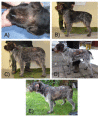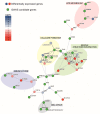Genomic and Transcriptomic Characterization of Atypical Recurrent Flank Alopecia in the Cesky Fousek
- PMID: 35456456
- PMCID: PMC9033119
- DOI: 10.3390/genes13040650
Genomic and Transcriptomic Characterization of Atypical Recurrent Flank Alopecia in the Cesky Fousek
Abstract
Non-inflammatory alopecia is a frequent skin problem in dogs, causing damaged coat integrity and compromised appearance of affected individuals. In this study, we examined the Cesky Fousek breed, which displays atypical recurrent flank alopecia (aRFA) at a high frequency. This type of alopecia can be quite severe and is characterized by seasonal episodes of well demarcated alopecic areas without hyperpigmentation. The genetic component responsible for aRFA remains unknown. Thus, here we aimed to identify variants involved in aRFA using a combination of histological, genomic, and transcriptomic data. We showed that aRFA is histologically similar to recurrent flank alopecia, characterized by a lack of anagen hair follicles and the presence of severely shortened telogen or kenogen hair follicles. We performed a genome-wide association study (GWAS) using 216 dogs phenotyped for aRFA and identified associations on chromosomes 19, 8, 30, 36, and 21, highlighting 144 candidate genes, which suggests a polygenic basis for aRFA. By comparing the skin cell transcription pattern of six aRFA and five control dogs, we identified 236 strongly differentially expressed genes (DEGs). We showed that the GWAS genes associated with aRFA are often predicted to interact with DEGs, suggesting their joint contribution to the development of the disease. Together, these genes affect four major metabolic pathways connected to aRFA: collagen formation, muscle structure/contraction, lipid metabolism, and the immune system.
Keywords: Cesky Fousek; GWAS; RNA-seq; atypical recurrent flank alopecia; canine alopecia; differential gene expression; dog; skin biopsies.
Conflict of interest statement
The authors declare no conflict of interest. The funders had no role in the design of the study; in the analyses or interpretation of data; in the writing of the manuscript; or in the decision to publish the results.
Figures





References
-
- Lequarré A.-S., Andersson L., André C., Fredholm M., Hitte C., Leeb T., Lohi H., Lindblad-Toh K., Georges M. LUPA: A European initiative taking advantage of the canine genome architecture for unravelling complex disorders in both human and dogs. Vet. J. 2011;189:155–159. doi: 10.1016/j.tvjl.2011.06.013. - DOI - PubMed
-
- Marsden C.D., Ortega-Del Vecchyo D., O’Brien D.P., Taylor J.F., Ramirez O., Vilà C., Marques-Bonet T., Schnabel R.D., Wayne R.K., Lohmueller K.E. Bottlenecks and selective sweeps during domestication have increased deleterious genetic variation in dogs. Proc. Natl. Acad. Sci. USA. 2016;113:152–157. doi: 10.1073/pnas.1512501113. - DOI - PMC - PubMed
Publication types
MeSH terms
LinkOut - more resources
Full Text Sources

